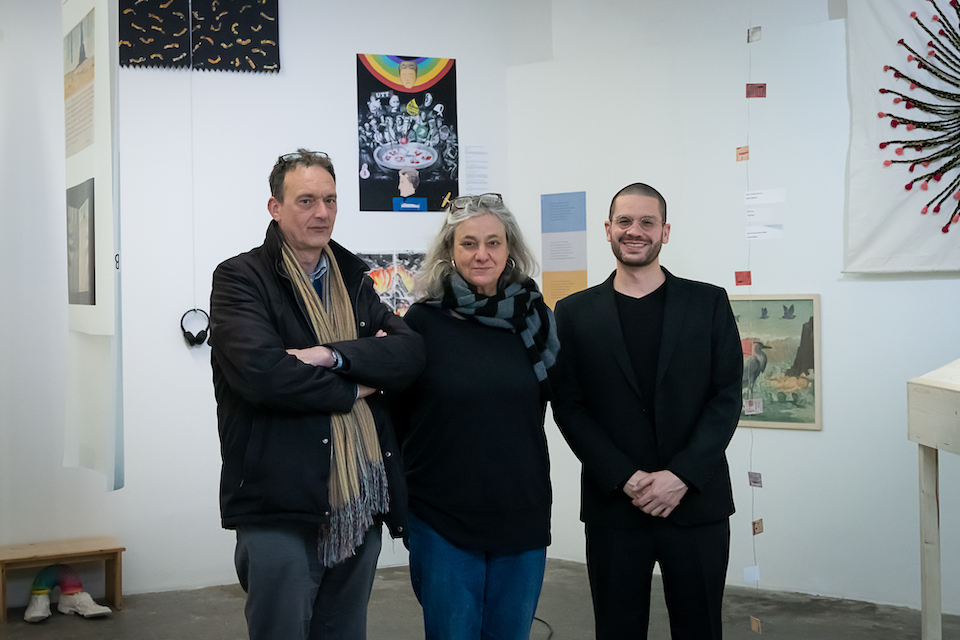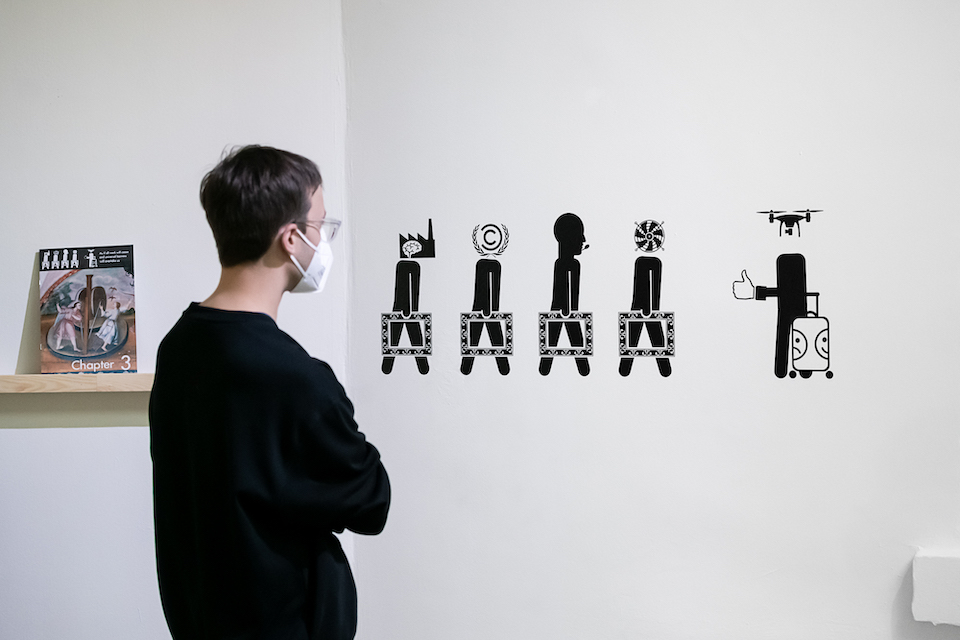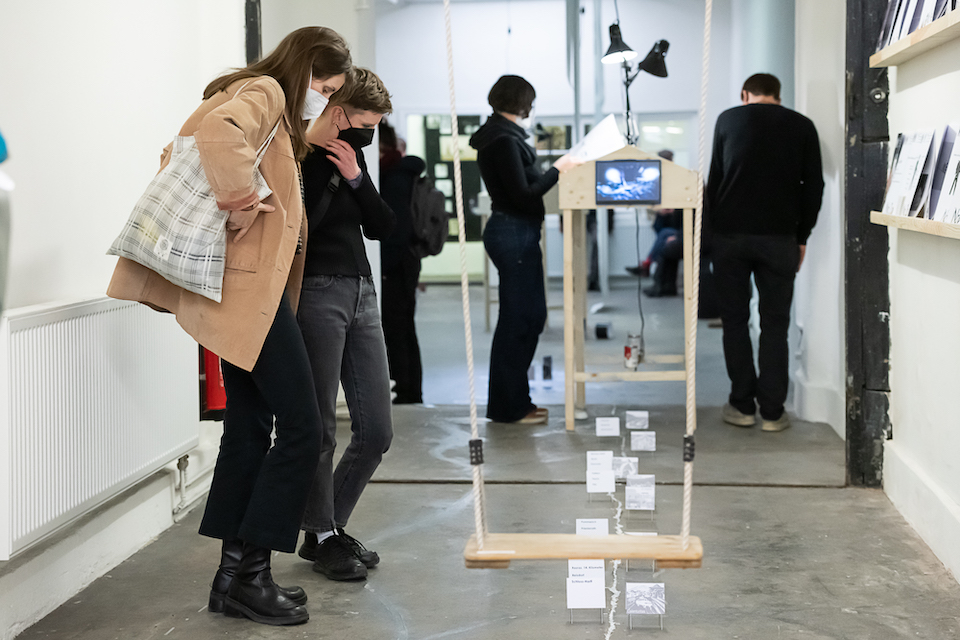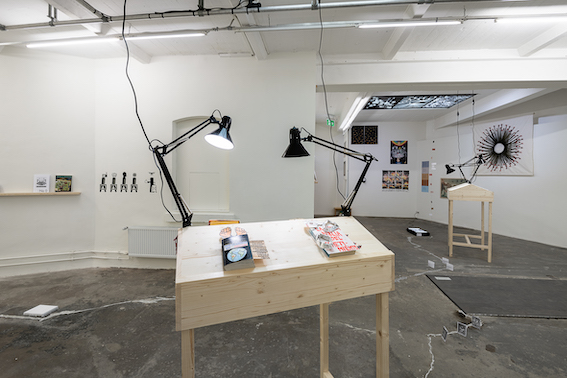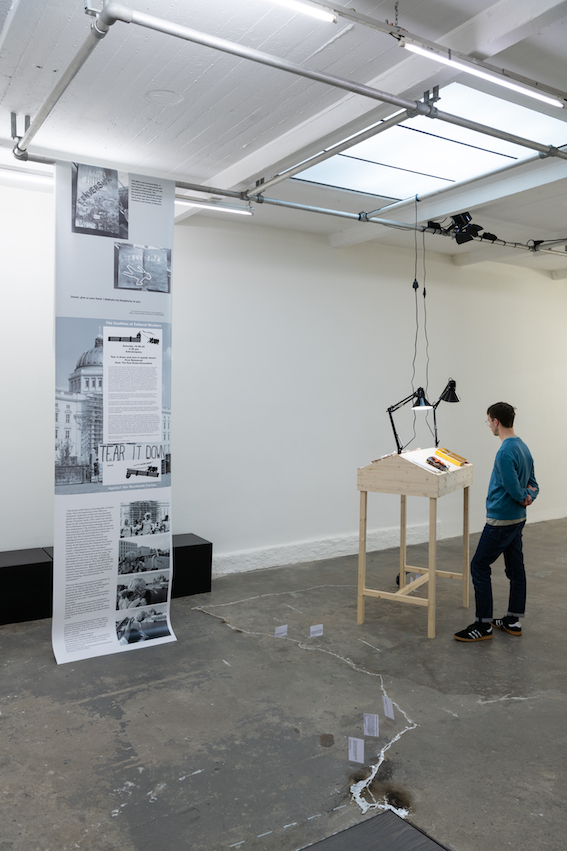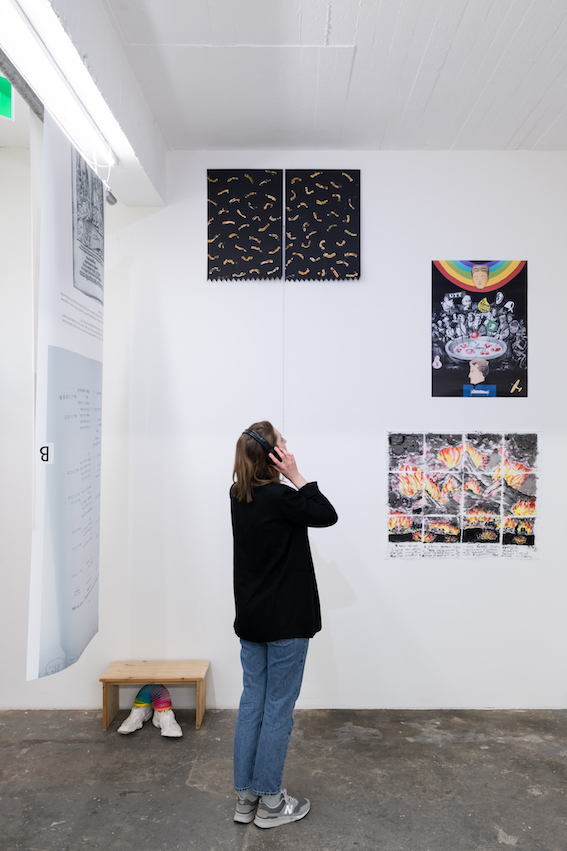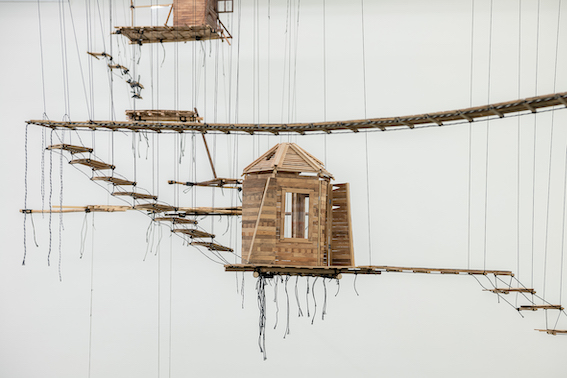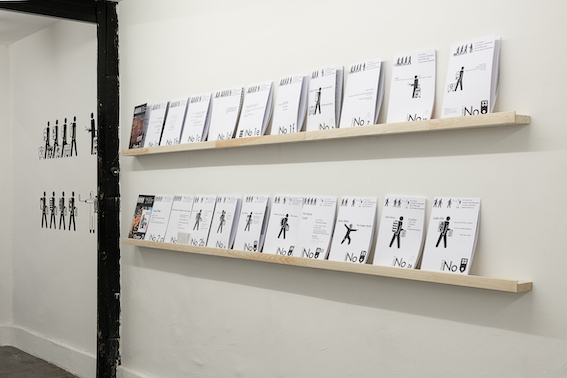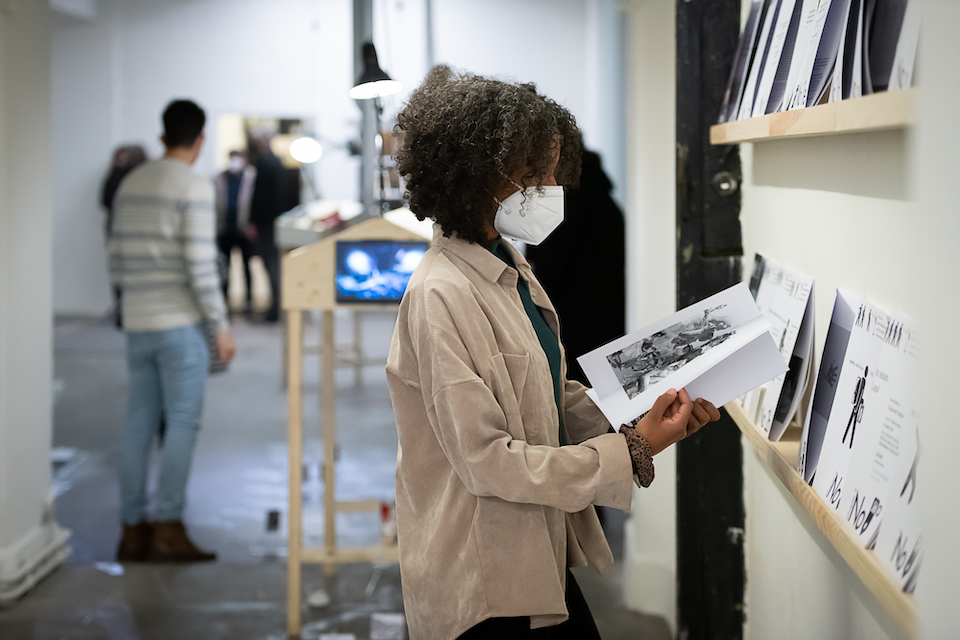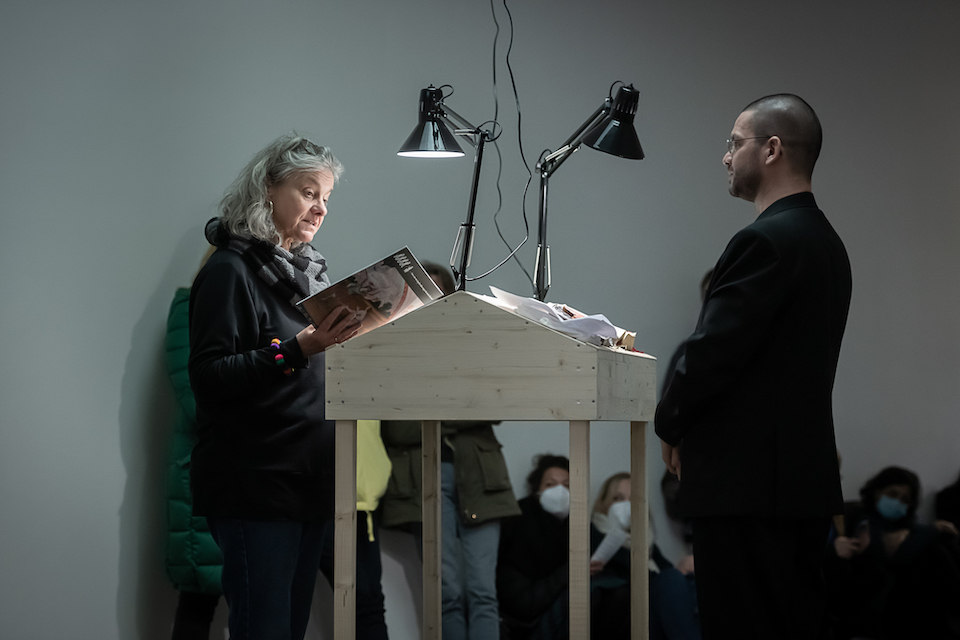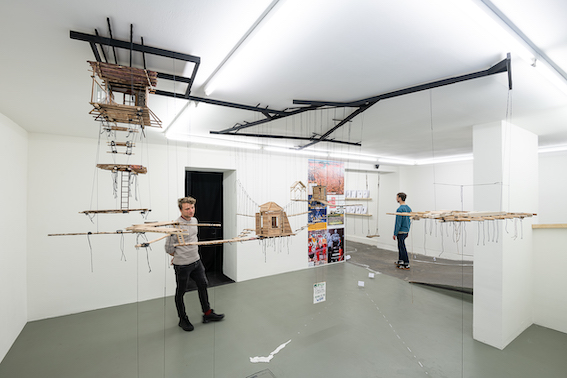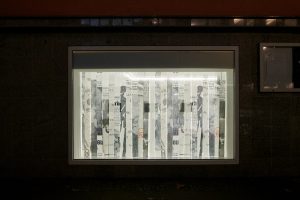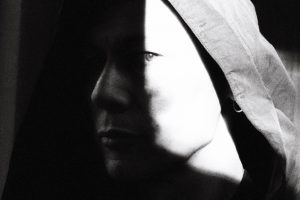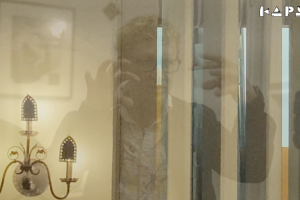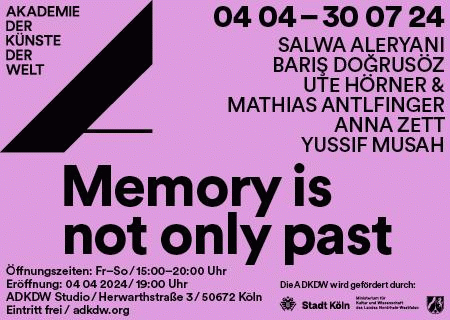“We pursue a lot of things out of a need to rewrite history – and to keep bringing it back to a contemporary social practice.”
The idea to create an archive about the Potosí project arose, according to Alice Creischer and Andreas Siekmann, at the suggestion of the curator at the House of World Cultures, Berlin, Anselm Franke in May 2017. Whereby it was quickly clear to the two that it was not to be an archive in the classical sense, rather Creischer and Siekmann wanted to dedicate themselves to the blind spots of the original exhibition “The Potosí Principle” (which they had implemented together with Max Jorge Hinderer Cruz, the current Artistic Director of the Akademie der Künste der Welt) and the resulting follow-up questions.
The title of the original exhibition refers to the city of Potosí, which, located in what is now Bolivia, was the center of one of the most important silver mining areas in the world between the 16th and 18th centuries. Potosí served as an impetus for the trio to think about ecological issues related to the exploitation of nature, to come to terms with the colonial exploitation of South America by the European trading nations, and to question the effects on the global economic cycle that resulted from these processes. One could also say: by dealing with Potosí, Creischer, Hinderer Cruz and Siekmann uncovered the realization that the formation of modernity and the processes of globalization, and thus the genesis of European industrialization and banking, would not have been possible without the oppression and exploitation of another continent.
The result of Alice Creischer’s and Andreas Siekmann’s intensive research work now manifests itself in an exhibition archive that rotates around four project questions: the question of primitive accumulation, the question of human rights, the question of the role of art, and the question of the topsy-turvy world, put into shape for the exhibition and beyond in 36 brochures.
Thomas Venker met Alice Creischer and Andreas Siekmann in the exhibition rooms of the Akademie der Künste der Welt for a tour of “Potosí-Principle-Archive” and a conversation lasting several hours.
Alice, Andreas, what made you decide to now edit the exhibition you conceived and realized together with Max Jorge Hinderer, which was shown in 2010/2012 at the Reina Sofia Museum in Madrid, the Haus der Kulturen der Welt in Berlin, and the Museo nacional de Arte as well as the MUSEF in La Paz, with an archive?
Alice Creischer: The exhibition has been discussed extensively over the past ten years. At that time, it was very unusual that the exhibition was not only shown here, but also in La Paz – exhibitions from the so-called “Global South” are often shown in Europe, but hardly ever go back to the places where the artworks are from, , for example to South America. The exhibition at that time showed colonial paintings and the works of contemporary artists who responded to them. I think it was one of the first exhibitions that pursued a postcolonial discourse. We were not aware of that at the beginning, it came only through the selection practice of the works and the discussions between the artists and us – both led to an echo in relation to the postcolonial discussions.
Andreas Siekmann: Until then, postcolonial discourse was a campus phenomenon and knew no practice. The colonial paintings we selected wandered for the first time in an art context. The paintings that were commissioned by Europe and painted in the colonies according to European models were not art for our form of historiography; at most, they appeared in ethnological collections, but not circulated. To show these pictures after 300 years in an art context and then also in the museum Reina Sofia in Madrid, that was new. 90 percent of these pictures were painted anonymously, had no addressee,. Actually, Baroque painting in its presence in the colonies (in South America, the Philippines) was the first global style of painting, but these paintings had been forgotten by art history.
Could you see different reactions to the exhibition in the three countries at that time?
Andreas Siekmann: The exhibition was perceived very differently in all three places. In Spain, it triggered a reappraisal of colonial history and restitution issues; in Berlin, it met with a particularly postcolonial reception; in La Paz, it was perceived as a complement to the decolonial practice and theory of the government of the time. It was important to us that the exhibition went from Berlin back to La Paz, because that is normally never the case and reflects the principle of scientific and cultural extractivism institutionally. There are many institutional hurdles to overcome.
Whereby these discussions are already part of the enlightenment process that you associate with the exhibition.
Andreas Siekmann: At the time, the institutions received funds from the EU, which in 2011 celebrated the 200th anniversary of the so-called liberation of South America, that is, the formation into nation states with a Spanish or mestizo elite. In terms of borrowing the paintings from Bolivia, we quickly discovered that many paintings we wanted we didn’t get at all. Once, because of the size of some of the images, especially those that are part of a Postrimeria cycle, that is, pictorial stories that are about death, judgment and hell and that completely fill the church walls of some communities near Lake Titicaca. The cinematic format, just like the depiction of hell, was meant to intimidate people. The images served a program of re-education, they were there to eradicate indigenous culture and worldview. These images were difficult to transport because of their size.
Alice Creischer: In addition, there were the difficult negotiation processes with the communities. In Bolivia, the indigenous communities have a right of co-determination over their cultural assets. But an exhibition at the Reina Sofia Museum in Madrid is completely meaningless to these communities. Instead, there were tangible material demands, for example, highland tractors or electricity.
Andreas Siekmann: In addition, there were fears that we might repaint the works and return copies. That tells a lot. Today, a large part of the colonial paintings are in the collections of elite U.S. universities or in European ethnological museums.
- Photos: Katja Illner
Alice Creischer:We encountered fundamental skepticism in Bolivia during the selection process, and beyond that we were confronted with our own curatorial gaze. Once we visited a church in a small community and expressed our interest in a painting. After that, it disappeared. Because our gaze as European curators is a value-added gaze . In Europe, the other side of this coin became apparent: For our exhibitions in Madrid or in Berlin, we could have had pictures or objects from the Museo de las Americas in Madrid or from the Ethnological Museum in Berlin, but not for the exhibition in La Paz. Because then restitution claims would have taken effect. The Ethnological Museum in Berlin has 350 quipus, thread knots, indigenous memory instruments that record deliveries of goods, land boundaries or histories. In total, there are 500 historical quipus in the world.
Andreas Siekmann:But it was still important to us to show the pictures that didn’t come. We then showed them in their original size either as a drawing, a film or a copy and then also revealed the reasons why the pictures did not come. Because in these reasons a part of the colonial history and present is revealed. To make that clear in the whole concept of the exhibition, we didn’t want the pictures we had to hang on the walls normally in the sense of “So, now we’ve overcome colonialism!” There are no walls for these paintings, so we didn’t show them on walls to make it clear that they have no status here.
In the Prado Museum in Madrid, for example, ten years ago, when we asked, they said that there would be no such paintings in a royal private collection because that collection was committed to the history of painting. Today there is a large exhibition there about colonial paintings in Spanish possession. That would have been impossible ten years ago, in a house where paintings by Goya etc. are shown.
A lot has happened since then. Would you say that it works for you and facilitates the transfer of your concerns?
Alice Creischer: A lot has happened in the last decade. You can see that in the current exhibitions on the revision of the Brücke artists or on Gaugin in Berlin, in which their colonial involvement is revealed. However, this is often at the expense of a historically broader contextualization. Instead, artists are morally condemned instead of seeing colonialism as part of a political and economic system that continues to this day.
Andreas Siekmann: Institutions like the Humboldt Forum in Berlin do nation branding with a specious tolerance and cultural openness, while dragging out restitution issues or embracing them to death, so to speak. Piece by piece – as with the forced labor debate – pressure must be built up from the outside. Often this pressure is then appropriated and their own legitimacy transformed. The Humboldt Forum is a very mendacious institution.
Alice Creischer: It is precisely this way of dealing with postcolonial discourses that perhaps brings us back to the initial question: why an archive of this project ten years later. These issues of image lending and restitution are good examples of that.The Humboldt Forum is a very good example of white washing because it pretends to actually question its gigantic trove of looted artifacts from around the world. However, it remains an outrageous gesture of domination even as an architectural complex. A Prussian palace will be rebuilt on the site of the former Palace of the Republic, which will then house the Ethnological Collections.
Andreas Siekmann: In the current archive, a booklet tells us that the Otto family sponsored a cross for the dome of the Humboldt Forum in 2020. The inscription on the orb of the cross says that the entire world, the living and the dead, must bow their knees to Jesus.
Alice Creischer: We have followed up with the archive over the past ten years on the themes and questions we had at the time, to see how things are today with questions of original accumulation, human rights, art as an agent of a Western hegemony.
Andreas Siekmann: The baroque paintings were meant to subjugate people in the colonies. Now, in view of the biennials around the world, the question arises for contemporary artists about their own role – are they the soft factor of economic expansions? Are biennials there to open up economic spaces? Another focus of the archive is to continue the question of original accumulation. When we started the project in 2008/2009, it was at the time of the global financial crisis – . Our project addressed the first global circulation of money with the silver coin from Potosí in the 16th century , but we could not adequately reflect the financial crisis in it because we were in the eye of the storm, so to speak. We could not yet grasp the full scope. That’s why we’ve now addressed the financial crisis and its effects – debt, enrichment of the few, the rise of digital capitalism – in the archive.
To what degree do you hope for concrete socio-political changes through such an exhibition project?
Alice Creischer:We come from the anti-globalization movement, which was characterized by a confidence that we could influence politics through protests and international networks of solidarity. This confidence has now been destroyed. At the latest since the outbreak of war in Ukraine, it is clear that government policy can no longer be invoked, cannot be influenced by protests. It is now following a national chauvinism, which is occurring because the international community of states is incapable of averting the climate catastrophe. Russia will not remain the only chauvinist in this. This leads to sublimation in the cultural sphere: trying to make the choice of words as politically correct as possible, or maintaining the diplomatic etiquette of institutional transparency – but all of this comes up against this absolute limit of not being able to influence macro-political and economic decisions.
What does that do to your own motivational curve?
Alice Creischer: It leads to finding it incredibly important to create one’s own networks, one’s own liabilities. I think the Potosí project and also its archive establish such a liability of a discursive and artistic space in Argentina and Bolivia, in Spain, in London, in Moscow, in Petersburg, in Beijing … – this space did not emerge as a selective curatorial process, but was a snowball effect. A friend knows this one or that one and they in turn… thus a network of friendships has formed over a continuum of ten years. We see in this exhibition and the archive a kind of artistic action, because it creates commonality.
Andreas Siekmann: In the exhibition and in the archive, we show social practices that operate beyond the appeal to a state policy, and ultimately that’s the only thing we have left at the moment.A good example is Mujeres Creando in Bolivia, co-founded by María Galindo. For twenty years they have been running a feminist collective that advocates for the rights of prostitutes, LGBTQ people, and market women. Their practice is encouraging because it is self-organized, autonomous and militant.
Another example is the work “Beechtown/Blutbuchingen, Hambacher Forst: models of the activists’ tree houses” by Stephan Mörsch in the exhibition – a political practice that protests against lignite mining and German energy policies.
The activists are aware that they cannot change the catastrophic effects of climate change, but they send important signals in a highly industrialized country like Germany. Especially since the activists on the ground come from all over the world. You’re much further ahead here than politics is from awareness, because you know that you have to unite the struggles internationally.
Alice Creischer: In the archive, such practices are linked to a historical plumb line. It goes, for example, from the present in Hambach Forest and the lignite extractivism there to the famous example of silver extractivism in Potosí – these are the paths that the project traces.
The exhibition functions under the signet project. How important is this conceptualization to grasp “Potosi Principle”?
Alice Creischer: Since the 90s, many exhibitions call themselves “projects” This was due to the lack of contextualization that had arisen in the run-down male painter lord art scene of the 80s. It’s no longer possible to just hang paintings in a room and say this is me and me and me. In order to really take an artistic practice seriously, it had to be related to social and historical contexts again.
First of all, a project requires a long-term perspective and an openness to results A biennial can never be a project – the money always has to be spent in two years, which is why no biennial can be good.
Secondly, a project builds very strongly on communication and feedback between the participants – explicitly against the extreme form of hierarchization that was still known in the art context of the 80s, where mostly male curators selected the artists.
As always, this project idea is ambivalent, because the buzzwords “dissolution of hierarchies”, “flexibilization of work”, where fixed jobs then became “projects”, are also familiar from the neoliberal corporate language of the 90s, in which labor rights and social rights were quickly wound up along with them. So the concept of the project has evil siblings.
The other two trigger terms are “principle” and “archive”. Perhaps you could also briefly explain here how this setting came about and what that means exactly for the exhibition context.
Alice Creischer: Principle has a double linguistic meaning, in Spanish Principio also means the beginning. We liked that. Potosí is, after all, one of the initial places of global economy due to the silver extraction that started the dynamics of the modern capitalist economy in Europe; the Potosí coin was one of the global first currencies.
It also explains a principle of exploitation and extractivism that is repeated all the time – we are looking for the places where the Potosí principle is repeated.
Andreas Siekmann:That’s how the various cities in the Potosí project came to be the Potosí of today: Dubai, for example. Potosí did the same thing: they had to attract investors to build lakes, secure energy supplies, organize labor regimes-these were international investors even then.
Alice Creischer: Labor was organized in Potosí through a forced labor system, a system like in feudal Europe, where people were obligated to work the front – only more excessive there. This was not enough, however; the hunger for silver was so great that people were dying too quickly, so a form of speculation on labor occurred. Value bills were put up for labor that would eventually come. This, of course, reminded us of futures, derrivate, value investing
Because of all these many references, the archive is very extensive We pursue many things out of a need to rewrite history – and to keep bringing it back to a contemporary social practice.
Central to the “Potosi Principle – Archive” are the 36 artistically designed booklets already alluded to It is not so much a matter of singular positions (for all their independence), but rather of a network of artistic works designed as a dialog biotope on the themes of decolonization, extractivism, inquisition and capitalism.
How do I imagine this process of curation in concrete terms: has it been a linear additive procedure or rather 2 steps forward, 1 step back, 3 to the left and 2 to the right? How much certainty and stability is there, how fragile are the findings?
Alice Creischer: That was certainly true during the deliberations about making an archive in the first place. We did have these four basic questions that were structurally very important and led to the four chapters: on accumulation, on human rights, on the role of art, and on the world upside down in terms of forms of resistance. Ten years ago there were many chronicles that we couldn’t work on at all, but where there was still a lot. With many artists we had the feeling that we could not adequately explain their work, many of whom, like us, also have large archives.
So the question was rather: why do you stop? When does one have the feeling that the story is finished?
- Photos: Katja Illner
Even now it doesn’t stop completely. There is an extensive supporting program of discussions and reading groups (about/on violence) and readings (from the archive) as well as seminars on the exhibition, which continues your work.
Alice Creischer: The archive can manifest itself in this block (points to catalog), but of course it has to live on otherwise and translate into another practice.
Do you feel that the other side, the capitalist system is as meticulous as you are?
Alice Creischer: Totally. For example, we did an interview with Phillip Mirowski, author of the book “Never let a serious crisis go to waste” – he was one of the first to write about his astonishment that after the crisis the banks and financial institutions just carried on as before. We all thought in 2008: now you get it! Now comes the Tobin tax! Now the state will regulate the banks!
Andreas Siekmann:He warned early on about phenomena like Trump – and that was because the left would not understand the neoliberal networks and the process of capitalist digitalization.
Alice Creischer: There are certain problems like the financial crisis or the climate crisis and they are answered differently from different sides. From the neoliberal side, you can set up a fund and invest in aluminum particles that are blown into the air so that the sun doesn’t shine as much. From another side, one occupies a small forest near a brown coal mining area.
But how can you then explain the fact that politicians no longer keep up and, for example, do not see the economic and ecological risks behind cryptocurrencies?
Alice Creischer: Since the 1970s, there has been a disempowerment of politics, especially with regard to economic policy competencies. Politics has surrendered its instruments.
What’s exhausting about the Bitcoin currency is its value discovery. It consists of how much computer power is needed to coin it. It takes an entire factory floor of computers to mint a coin. In other words, the value coverage of the currency consists of the mere senseless consumption, the burning of energy, where energy is the scarcest commodity.
Andreas Siekmann: A coin has approximately the energy of the state of Denmark.
Alice Creischer: Similar to a war, in which grain silos and oil depots are bombed, tanks and ships are blown up, a daily outrageous heating up of the climate, as if the creation of value is heading for the scarce resource, where can one still live in 40 years.
A keyword here is certainly resource. You have invested a lot of time and energy in your research. The economy is doing the same. Politics doesn’t have this time; everyone is on a tight schedule.
Alice Creischer: In the neoliberal turn since the end of the 70s, politics has privatized all institutions that could function in the long term. They have sold their instruments! If you have a policy that is powerless in terms of economic policy, then you don’t have a policy – you have a diplomatic corps.
Andreas Siekmann: Politics is a representative. If something is to be done about the energy turnaround, it’s done by experts, think tanks and rating agencies That’s outsourced. The bills are written by external companies. These consulting firms and think tanks, which are not elected by parliament, are considered to have more competence than any NGO.
What does all this mean for the scope of action of artists? And the art? What criteria do you use to select the works for such a project?
Andreas Siekmann:An art that says that you can simply let it have an effect on you and that you don’t have to think about anything else, that is not freedom for us – but carries the danger of producing a structural blindness.
Alice Creischer: But it’s not the case that our friends whose works hang here have to cope with the ballast of having to read everything before they are allowed to make art. We have friends who come from their own very intensive artistic practice. When they collaborate with us, part of that meets a sliver of the archive as a response. Different intense pursuits come together. Our task is to collect everything and combine it into a context of meaning.
Are there also artists who are surprised because they didn’t intend the work that way?
Alice Creischer: When we approach artists, we have usually already gone a long way together. Some artists knew about the “Potosí Project” and – without us knowing – made works that responded to it. For example, the Bolivian documentary narrator Miguel Hilari responded to a film by Harun Farocki that he produced for our project 10 years ago.
Andreas Siekmann: Parallels keep happening. The cross on the Humboldt Forum was placed at the same time as the coup in Bolivia – in the coup, a clerical-fascist government came to the palace with the Bible to exorcise the indigenous spirit of the Evo Morales government. And in Berlin, a palace is being built to erase socialist history and reintroduce Prussian chauvinism.
Alice Creischer: In general, we have many artists with us who see themselves as artists in the classical sense, but also those who act in collectives, up to and including activism. In the meantime, everyone in the art field has their own branch and sector. This diversification also saves fundamental discussions about what art actually is. Everyone has his or her niche. We are lucky to have “classical” artists participating in our project, as well as activist groups like Mujeres Creando – we thus have the chance to have a different and broader discourse about what it actually is, artistic practice.
It is important that we arrive at a form of artistic action that unites us through diversification. Also to save art as a practice.
Thank you very much for the detailed conversation.
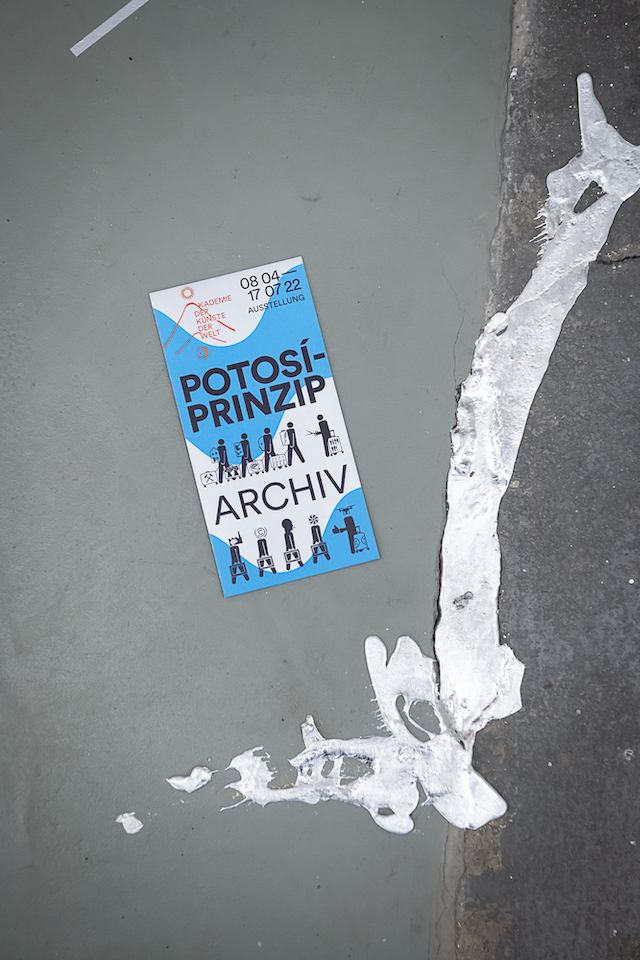 POTOSÍ-PRINZIP – ARCHIV
POTOSÍ-PRINZIP – ARCHIV
Akademie der Künste der Welt
ACADEMYSPACE. Herwarthstraße 3 50672 Köln
Fr 08 04 – So 17 07 2022







